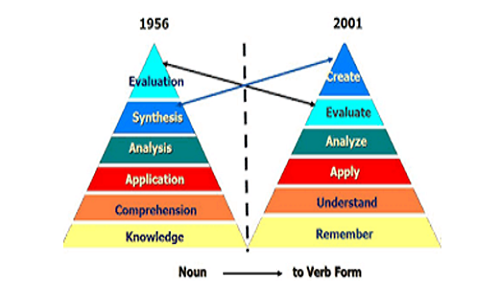
A Portrait of English Secondary Teachers in Indonesia in Exploiting Questions Referring to Bloom’s Taxonomy
Abstract
Abstract
This study sheds light on the skill of three secondary school English teachers in Indonesia in making use of questions referring to the Bloom’s Taxonomy to keep students engaged in the course of the lesson. It adopts qualitative content analysis where the stages of decontextualization, recontextualization, categorization, and compilation were conducted. Three YouTube videos which provide the teaching performance of these three teachers had been the data collected in this study. From the findings, it discovers that these three English teachers still preferred applying the lower-order thinking questions to higher-order thinking questions which had been the type of teachers in Asia, including Indonesia. Consequently, students did not get ample chance to develop their critical thinking skills. This study therefore highly recommends that teachers need to get much exposure to the higher-order thinking questions as it is one of the demanding skills needed in the 21 first century.
Keywords
Full Text:
PDFReferences
Anderson, L. W., & Krathwohl, D. R. 2001. Taxonomy for learning, teaching, and assessing. New York: Longman.
Almeida, P., & Neri de Souza, F. (2009). Patterns of Questioning in Science Classrooms. In M. Muñoz and F. Ferreira (Eds.). Proceedings of the IASK ( International Association for the Scientific Knowledge) International Conference “Teaching and Learning 2009”. Porto, Portugal, 7- 9 pp. 125-132.
Atika et al. (2013). The role of questioning technique in developing thinking skills: The ongoing effect on writing skill. Procedia - Social and Behavioral Sciences 70 pp. 1024 – 1031
Aydemir Y, Çiftçi Ö. (2008). Literature Teachers' Questioning Skills: A Study on (Gazi University Faculty of Education Case), Centenary University J. Faculty Educ. 6(2):103-115.
Berg, B. L. (2001). Qualitative research methods for the social sciences. Boston: Allyn and Bacon
Bloom, B. (1956). Taxonomy of educational objectives: The classification of educational goals. London: Longman.
Burnard, P. (1991). A method of analysing interview transcripts in qualitative research. Nurse Education Today, 11, 461–466
Chin, C., & Osborne, J. (2008). Students' questions: a potential resource for teaching and learning science. Studies in Science Education, 44, 1-39. Floyd, W. D. (1960). An analysis of the oral questioning activities in selected Colorado classrooms PhD. Thesis. Colorado: Colorado State
College, Graesser. A., & Olde. (2003). How does one know whether a person understands a device? The quality of the questions the person asks when the device breaks down. Journal of Educational Psychology, 95, 524-536.
Debora, Tri Ragarwanti. (2009). Questions and Questioning Techniques: A View of Indonesian Students’ Preferences. Journal KATA. Vol. 11, Number 2 pp. 155 - 170
Güftâ H, Zorbaz KZ (2008). Turkish Course Level of Secondary School Examination questions on Evaluation. Cukurova University J. Institute Soc. Sci. 17(3):205-218
Graneheim, U H., & B Lundman. (2004). Qualitative content analysis in nursing research: concepts, procedures and measures to achieve trustworthiness. Nurse Educ Today. 24(2), pp. 105-112
Morse, J. M., & Richards, L. (2002). Read me first for a user's guide to qualitative methods. Thousand Oaks, California: Sage Publications Inc.
Özcan S, Akcan K (2010). Examination of the questions prepared by science teachers and their compliancewitho the content of Bloom's Taxonomy. Kastamonu Educ. J. 18(1):323-330
Paramartha, et al. (2018). Types, Purpose, and Strategies of Teacherss Questions in Indonesian EFL Classroom of Junior High School in Bali. International Journal of Language and Literature. Vol. 2 No.1
Patton, M. Q. (2002). Qualitative, research & evaluation methods. Thousand Oaks, California: Sage publications Inc
Paul, R., & Elder, L. (2004). The Nature and Functions of Critical and Creating Thinking. The Foundation for Critical Thinking: Dillon Beach, CA.
Sunggingwati, Dyah., & Mai Nguyen, Hoa Thi. (2013). Teacher's Questioning in Reading Lesson: ACcase Study in Indonesia. Electronic Journal of Foreign Language Teaching, Vol. 10, No. 1, pp. 80 – 95. Centre for Language Studies http://e-flt.nus.edu.sg/National University of Singapore
Sulistyo, Urip. (2015). Improving English as a Foreign Language Teacher Education in Indonesia: The Case of Jambi University [Unpublished Doctor’s Dissertation]. RMIT University. Melbourne
Ragawanti, Tri Deborah. (2009). Questions and Questioning Techniques: A View of Indonesian Students’ Preferences. Journal KaTa. Vol. 11, Number 2, pp. 155-170
Tyas et al. (2019). Developing Higher Order Thinking Skills (HOTS) – Based-Questions: Indonesian EFL Teachers’ Challenges. Proceeding of the 2nd International Conference on Future of Education, Vol. 2, Issue 1. pp. 52 – 63
Ülger Ü (2003). Primary 6, 7, 8th grade in Turkish Language Examination questions on Evaluation [Unpublished Master's Thesis]. Gazi University Institute of Educational Sciences. Ankara.
DOI: http://dx.doi.org/10.31258/jes.4.4.p.907-916
Refbacks
- There are currently no refbacks.
Copyright (c) 2020 Dahnilsyah Dahnilsyah

This work is licensed under a Creative Commons Attribution 4.0 International License.
Publisher: FKIP Universitas Riau












